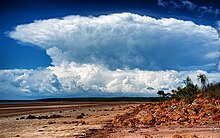Fixed anvil temperature hypothesis

Fixed anvil temperature hypothesis is a
Background and hypothesis
In the
The "fixed anvil temperature hypothesis" stipulates that owing to energetic and thermodynamic constraints imposed by the Clausius-Clapeyron relationship, the temperature and thus radiative cooling of anvil clouds does not change much with surface temperature.[1] Specifically, cooling decreases below −73 °C (200 K) as the ineffective radiative cooling by CO
2 becomes dominant below that temperature.[2] Instead, the elevation of high clouds rises with surface temperatures.[3]
A related hypothesis is that tropopause temperatures are insensitive to surface warming; however it appears to have distinct mechanisms from the fixed anvil temperature process.[4] They have been related to each other in several studies,[5] which sometimes find a fixed tropopause temperature a more reasonable theory than fixed anvil temperature.[6]
Evidence
The fixed anvil temperature hypothesis has been widely accepted and even extended to the non-tropical atmosphere. Its strength relies in part on its reliance on simple physical arguments.[7]
Models
The fixed anvil temperature hypothesis was initially formulated by Hartmann and Larson 2002 in the context of the NCAR/PSU MM5
The fixed anvil temperature hypothesis has also been obtained in simulations of
Observations
The fixed anvil temperature hypothesis has been backed by observational studies
Implications
Clouds are the second biggest uncertainty in future climate change after human actions, as their effects are complicated and not properly understood.[22] The fixed anvil temperature hypothesis has effects on global climate sensitivity, since anvil clouds are the most important source of outgoing radiation linked to tropical convection[23] and their temperature being stable would render the outgoing radiation non-responsive to surface temperature changes.[24] This creates a positive feedback component of cloud feedback.[25] The fixed anvil temperature hypothesis has also been used to argue that climate modelling should use temperature rather than pressure to model the height of high clouds.[26]
Alternative views
A hypothesis which would have the opposite effect on climate is the
Research
As of 2020[update] further research is needed to properly understand the physics of some cloud feedbacks,[31] as they differ between models,[32] and progress on properly modelling clouds globally is very slow.[22]
References
- ^ a b Hartmann & Larson 2002, p. 1.
- ^ Hartmann & Larson 2002, p. 3.
- S2CID 182771431.
- S2CID 118967908.
- ISSN 2169-8996.
- ^ Seeley, Jeevanjee & Romps 2019, p. 1849.
- ^ Seeley, Jeevanjee & Romps 2019, p. 1842.
- ^ Hartmann & Larson 2002, p. 2.
- ^ Del Genio 2016, p. 107.
- ^ Igel, Drager & van den Heever 2014, p. 10516.
- S2CID 146704580.
- ^ Noda et al. 2016, p. 2313.
- ^ ISSN 0022-4928.
- ^ Seeley, Jeevanjee & Romps 2019, p. 1848.
- ^ S2CID 198420050.
- .
- S2CID 146053272.
- PMID 25061956.
- S2CID 131478611.
- ^ a b Noda et al. 2016, p. 2307.
- ^ Noda et al. 2016, p. 2312.
- ^ a b Irfan, Umair (2021-05-19). "Scientists aren't sure what will happen to clouds as the planet warms". Vox. Retrieved 2021-07-05.
- ^ Hartmann & Larson 2002, pp. 1–2.
- ^ Hartmann & Larson 2002, p. 4.
- ^ Del Genio 2016, p. 116.
- ^ S2CID 135038760.
- S2CID 134486980.
- .
- ^ Igel, Drager & van den Heever 2014, p. 10530.
- ^ Igel, Drager & van den Heever 2014, p. 10531.
- ^ "Cooling effect of clouds 'underestimated' by climate models, says new study". World Economic Forum. 10 June 2021. Retrieved 2021-07-05.
- ISSN 0894-8755.
Sources
- Del Genio, Anthony D. (22 August 2016). "The Role of Clouds in Climate". Our Warming Planet. 1. World Scientific: 103–130. S2CID 187377009.
- Hartmann, Dennis L.; Larson, Kristin (2002). "An important constraint on tropical cloud – climate feedback". Geophysical Research Letters. 29 (20): 12–1–12–4. ISSN 1944-8007.
- Igel, Matthew R.; Drager, Aryeh J.; van den Heever, Susan C. (16 September 2014). "A CloudSat cloud object partitioning technique and assessment and integration of deep convective anvil sensitivities to sea surface temperature: CloudSat Objects and Sensitivity to SST". Journal of Geophysical Research: Atmospheres. 119 (17): 10515–10535. .
- Noda, A. T.; Seiki, T.; Satoh, M.; Yamada, Y. (16 March 2016). "High cloud size dependency in the applicability of the fixed anvil temperature hypothesis using global nonhydrostatic simulations: Cloud Size Dependency of FAT Hypothesis". Geophysical Research Letters. 43 (5): 2307–2314. .
- Seeley, Jacob T.; Jeevanjee, Nadir; Romps, David M. (2019). "FAT or FiTT: Are Anvil Clouds or the Tropopause Temperature Invariant?". Geophysical Research Letters. 46 (3): 1842–1850. S2CID 135276405.
